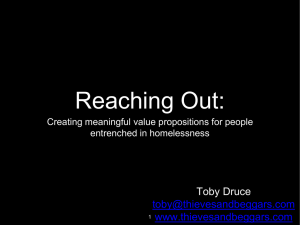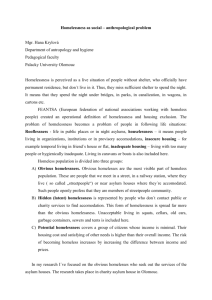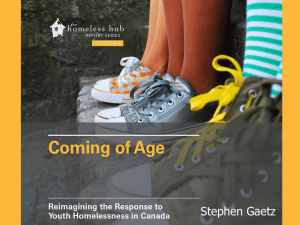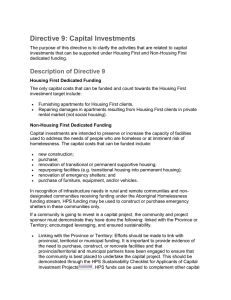Evaluation and Policy: How Are They Connected?
advertisement
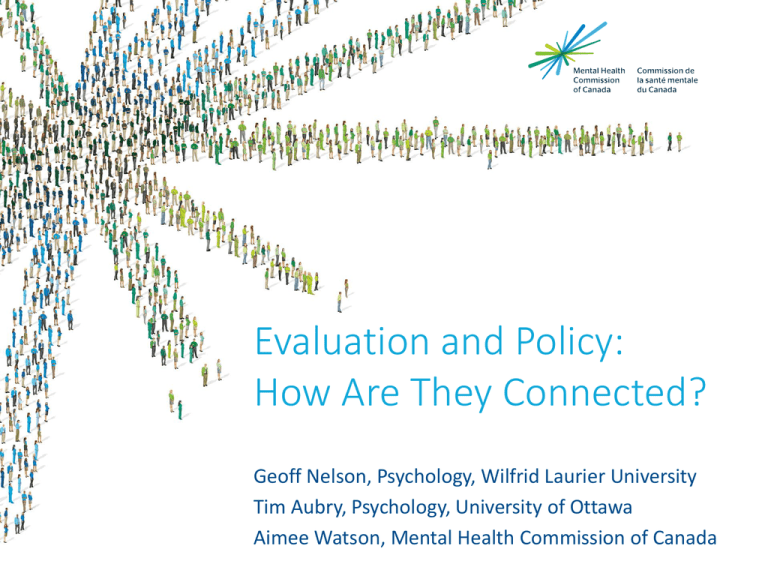
Evaluation and Policy: How Are They Connected? Geoff Nelson, Psychology, Wilfrid Laurier University Tim Aubry, Psychology, University of Ottawa Aimee Watson, Mental Health Commission of Canada Agenda 2:45-3:00 – introductions and expectations for the workshop 3:00-3:10 – policy 3:10-3:20 – evaluation 3:20-3:30 – knowledge transfer 3:30-3:50 – small group discussion 3:50-4:00 – reporting back on small groups Policy The renewal and repurposing of HPS • March 21, 2013, federal budget announcement, Economic Action Plan 2013 proposes $119 million per year over five years, nearly $600 million in total, to the Homelessness Partnering Strategy using a “Housing First” approach. • Building on the successful At Home/Chez Soi project, the Government will continue to work in partnership with provinces and territories, communities, the private sector and other stakeholders, such as the Federation of Canadian Municipalities, to reduce homelessness. Economic Action Plan 2013 proposes $119 million per year over five years for the Homelessness Partnering Strategy using a Housing First approach. Over the coming months, the Minister of Human Resources and Skills Development will work with Government partners at the community level to confirm the implementation details of this approach. Policy The renewal and repurposing of HPS • The evidence shows that the Housing First approach: can be implemented across Canada; improves the lives of those who are homeless and have a mental illness; and makes better use of public dollars, especially for those who are high service users—as demonstrated by a reduction in the use of hospital in-patient care, emergency rooms, police detentions and justice services. • The project will develop a body of evidence to help provinces and territories provide services to homeless people living with a mental illness. In addition, funding arrangements are being established to ensure that people participating in the project will have supports in place once the project is completed. Policy How did this renewal and repurposing of HPS happen? Evaluation and trusted messengers • At Home/Chez Soi research and MHCC knowledge translation • The conservative heartland – the Alberta experience and the emergence of the Canadian Alliance to End Homelessness led by Tim Richter • Looking south of the border – US research on Housing First, support from the G.W. Bush administration, development of 10-year plans to end homelessness in many US cities Policy How did this renewal and repurposing of HPS happen? Political will • • • • Dissatisfaction with progress in reducing homelessness in Canada Review of HPS provided an opportunity to refocus its approach Desire to do a better job of reducing homelessness in Canada An existing funding mechanism and program (HPS) Program Evaluation (Rossi et al., 2004) Definition “The systematic collection of information about the activities, characteristics, and outcomes of programs” Why Evaluate? 1. to make judgements about the program, 2. to improve program effectiveness, 3. to inform decisions about future programming” Make-Up of a Program PROGRAM MISSION NEEDS GOALS & OBJECTIVES VALUES & PRINCIPLES PROGRAM PROCESSES PROGRAM OUTCOMES INPUTS INITIAL OUTCOMES ACTIVITIES INTERMEDIATE OUTCOMES OUTPUTS LONGER-TERM OUTCOMES RELATIONSHIP TO THE THREE MAIN TYPES OF PROGRAM EVALUATION NEEDS ASSESSMENT IMPLEMENTATION / PROCESS EVALUATION IMPACT / OUTCOME EVALUATION Housing First Program Mission - Reduce Homelessness Program Processes HOUSING FIRST Outcomes Individual: + Housing Stability + Functioning + Quality of life Community: - Chronic & episodic homelessness Housing First: Assessment of Fidelity Housing First: Assessment of Fidelity Options 1. Self-asessment of fidelity (Gilmer, Stefanic, Sklar, & Tsemberis, 2013) 2. External assessment of fidelity (Mental Health Commisssion of Canada, 2014) Outcome Monitoring “The ongoing collection and analysis of information on indicators of how well programs are performing with regard to the achievement of results” (Rossi, Freeman, & Lipsey, 1999). Types of Outcome Measures Standardized self-report measures Simple counts of client status Collateral rating scales Consumer satisfaction measures Housing First: Outcome Indicators & Potential Measures 1. Housing status of clients (Simple count) 2. Community functioning (Multnomah Community Ability Scale – Collateral rating scale) 3. Quality of Life (Lehman’s Quality of Life Interview – Standardized self-report measure) 4. Consumer Satisfaction Measure – (Service Satisfaction Scale) Community-Level Outcomes Point-in-Time Counts A PIT is a snapshot of sheltered and unsheltered homeless people in a community on a single night. Why do a count? Provides a baseline Identifies needs of the populatioin Enables you to measure community level outcomes Helps identify priority populations Canadian Point-in-Time Count Methodology and Toolkit Piloted in Seven Cities in Alberta October 16, 2014 Who to Count? OPERATIONAL CATEGORY 1 2 3 4 1 Unsheltered Emergency Sheltered Provisionally Accommodated At-Risk of Homelesness LIVING SITUATION COUNTED o People living in public or private spaces without consent or contract ✔ 1.2 People living in places not intended for permanent human habitation ✔ Emergency overnight shelters for people who are homeless ✔ 2.2 Violence-Against-Women (VAW) shelters ✔ 2.3 Emergency shelter for people fleeing a natural disaster or destruction of accommodation due to fires, floods etc. 3.1 Interim Housing for people who are homeless 3.2 People living temporarily with others, but without guarantee of continued residency or immediate prospects for accessing permanent housing. 3.3 People accessing short term, temporary rental accommodations without security of tenure 3.4 People in institutional care who lack permanent housing arrangements. 3.5 Accommodation / Reception centres for recently arrived immigrants and refugees 4.1 People at imminent risk of homelessness 4.2 Individuals and families who are precariously housed. ✔ ✔ • Screening Mandatory questions • Consent • Gender • Age • Ethnicity • Migration • Immigration • Homelessness History • Veteran Status Using Program Evaluation to Develop and Improve Housing First Programs 1. 2. 3. 4. Conduct regular fidelity assessments Integrate outcome monitoring into service delivery Conduct regular point-in-time counts Provide training of service providers on data collection 5. Provide regular feedback on collected data 6. Keep analyses simple 7. Make program improvements based on collected data Knowledge Exchange “Evidence of effectiveness alone is rarely enough to ensure adoption of interventions” (Leff & Mulkern, 2002) What is Knowledge Exchange? The Canadian Institutes of Health Research defines KE as: a dynamic and iterative process that includes synthesis, dissemination, exchange and ethically-sound application of knowledge to improve the health of Canadians, provide more effective health services and products and strengthen the health care system www.cihr‐irsc.gc.ca/e/29418.html Knowledge Exchange How do you do it? Moving Knowledge to Action: • What? • Who? • How? Synthesis - 1 and 3 pagers, summaries, early findings Dissemination Exchange - media, community events, social media - Engagement, training, collaboration Knowledge Exchange Influencing Policy Lessons from the At Home/ Chez Soi experience: Throughout At Home/Chez Soi, the project team engaged in an ongoing process to work with government. Strategies included: • Worked with all levels of government (municipal, provincial, federal) • Regularly held in-person meetings and briefings throughout course of project • Developed briefing material- PowerPoint presentations, Early Findings reports • Used key messages to ensure consistent and focused messaging • Resulted in strong government engagement in At Home project sites and ongoing policy change Focusing the Frame A Participant Photography Project - 1 and 3 pagers, summaries, early findings - media, community events, social media My Kitchen View from my Window Advisory panels, collaboration, meetings __________________________ ________________________ I love to cook. On the street it's hard to get a I am so grateful for this view. I decent meal. Now my fridge is full and I can am also grateful to not have choose what and when I eat. I'm so much anyone able to knock on my healthier now, and I get so much satisfaction in window at all hours of the night. doing something I love to do. I can even invite I have some sense of safe. people over for a meal. Beats the hell out of a food kitchen. - Focusing the Frame A Participant Photography Project - Strings ____________________ The name “chaos theory” comes from the fact that the systems that the theory are apparently disordered. But 1 and 3 pagers, describes summaries, early findings Chaos Theory is really about finding the underlying order in seemingly random data. - media, community events, social media - The “butterfly effect” is a sensitive dependence on meetings initial conditions. Just a Advisory panels, collaboration, small change in the initial conditions can drastically change the long term behaviour of a system... I am the system Small Group Discussion Questions • How can your communities incorporate evaluation into your Housing First programs? • What knowledge transfer strategies could you use with policy-makers in your jurisdictions to promote the adoption of Housing First





